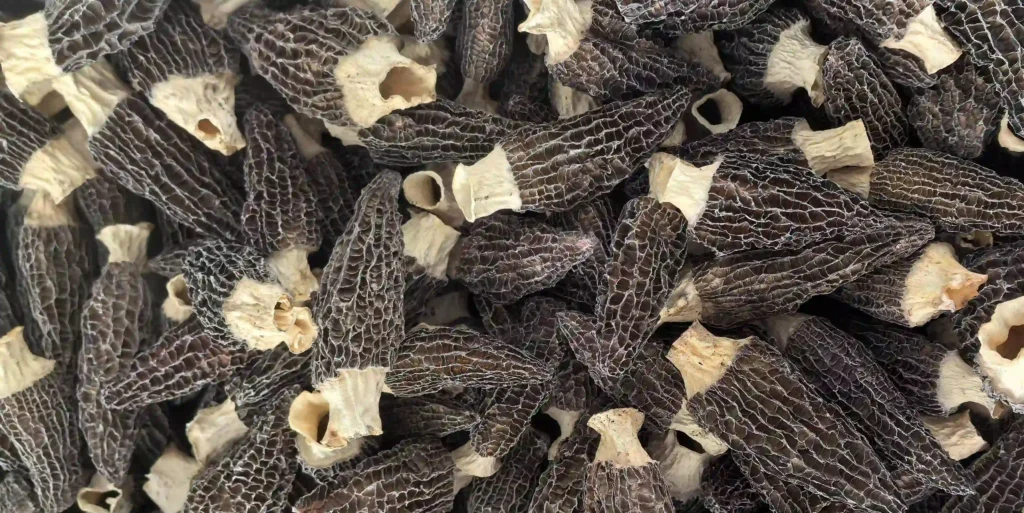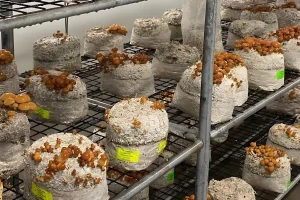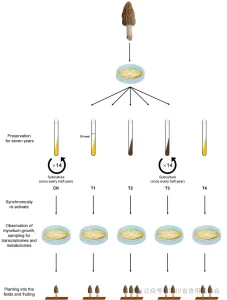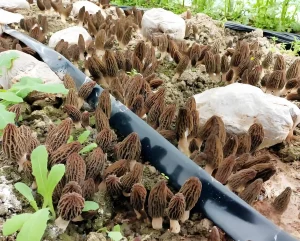A Thriving Journey from Wild Resources to Artificial Cultivation

Resources and Cultivation Development of Chinese Morels
China is rich in wild morel resources. Morels are mainly distributed in Europe, East Asia, and North America.
Global Distribution and Chinese Wild Resources Situation:
There are more than 60 phylogenetic species in the genus Morchella. 21 species are distributed in Europe, 22 in North America, and more than 30 in East Asia. Most of them are endemic species in their respective regions, and only a few are widespread species.
China is one of the main producing areas of wild morels, with a wide distribution from temperate to subtropical regions and a high level of species diversity. Relevant research shows that in recent years, 30 different phylogenetic species of morels have been discovered in China, distributed in five southwestern provinces (municipalities/autonomous regions)
such as Sichuan, Yunnan, Tibet, Chongqing, and Guizhou, as well as in 21 provinces, municipalities, and autonomous regions including Hubei, Gansu, Shaanxi, Henan, Shandong, Shanxi, Anhui, Guangdong, Zhejiang, Beijing, Hebei, the three northeastern provinces of Heilongjiang, Jilin, and Liaoning, as well as Xinjiang and Taiwan. However, due to the fact that the morphological characteristics of morels are easily affected by the environment, most of these species have not been named yet due to the lack of morphological characteristics for effective differentiation, and are only marked with the numbers of phylogenetic species.
Artificial Cultivation and Scientific Research Achievements of Chinese Morels
The continuously enriched cultivated varieties have placed China at the forefront of the world in the exploration of morel germplasm resources and the breeding of new varieties.
Germplasm Resources and Scientific Research Breakthroughs:
Germplasm resources of many artificially cultivable morels have been explored, such as Morchella importuna, M. sextelata, M. septimelata, and M. purpurascens. The world’s richest morel germplasm resource bank has been established, and the whole – genome sequencing and analysis of multiple morels have been completed. A new pathway for the formation of morel fruiting bodies has been discovered, complementing and improving the life cycle of morels.
At the same time, based on the exploration of germplasm resources, effective methods for breeding new morel varieties have been developed through breeding methods such as tissue isolation, multi – spore hybridization, and single – spore isolation. According to market demand, with genetic stability, high quality, and high yield as the breeding goals, a series of new varieties have been obtained. Currently, many species have achieved artificial cultivation, including Morchella importuna, M. sextelata, M. septimelata, and M. purpurascens in the black group.
Introduction to Main Artificially Cultivated Morel Varieties
(1) Morchella importuna
Cultivation Status and Variety Approval:It is the first morel species to achieve field artificial cultivation. Currently, there are 5 new varieties of Morchella importuna that have passed provincial – level approval in China, namely “Chuanyangdujun 1”, “Chuanyangdujun 3”, “Chuanyangdujun 4”, “Chuanyangdujun 5”, and “Chuanyangdujun 10”. The first four varieties were authorized with new plant variety rights by the Ministry of Agriculture in 2017.
Morphological Characteristics:Generally, the pileus of the ascocarp of Morchella importuna is brown to dark brown, the stipe is white to yellow – white, the density of the pileus ridges is medium, the longitudinal ridges of the pileus are obvious, and the fruiting bodies are both solitary and caespitose. The ascocarp is irregularly ovoid and conical, 4 – 12 cm long and 2 – 5 cm in diameter.
The surface of the pileus forms many pits, similar to a honeycomb; the stipe is hollow, 2 – 6 cm long and 1 – 3 cm in diameter, with granular substances on the surface and slightly enlarged at the base. The ascus is (250 – 300) µm×(17 – 20) µm, with 8 ascospores arranged in a single row, elliptical, (20 – 24) µm×(12 – 15) µm.
Advantages and Disadvantages:Its advantages are excellent commercial properties (the pileus has strong toughness, is resistant to storage and transportation, and has a relatively dark color), and it is suitable for fresh product sales and quick – freezing processing; compared with M. sextelata, it fruits later, and its resistance to high and low temperatures is inferior to that of “Chuanyangdujun 6” of M. sextelata.
(2) M. sextelata
Market Status and Variety Approval:It is the main group for artificial cultivation of morels, with a market share of over 70%. Currently, 5 new varieties of M. sextelata, “Chuanyangdujun 6”, “Chuanyangdujun 8”, “Chuanyangdujun 9”, “Kechuang 1”, and “Qianyangdujun 1”, have passed provincial – level approval, and “Chuanyangdujun 6” has been authorized with new plant variety rights by the Ministry of Agriculture.
Morphological Characteristics:Generally, the pileus of the ascocarp of M. sextelata is reddish – brown to dark reddish – brown or black, the stipe is smooth and white, the density of the pileus ridges is medium, the longitudinal ridges of the pileus are extremely obvious, the depression at the junction of the pileus and the stipe is not obvious, and the fruiting bodies are solitary or caespitose. The ascocarp is medium – sized, 5 – 12 cm long.
The pileus is nearly conical, 3 – 8 cm long and 2 – 5 cm in diameter, hollow, with a sunken surface, presenting a honeycomb – like shape; it is gray – white or gray when young, and gray – brown to black – brown with a slightly red tint or black when mature. The stipe is 3 – 6 cm long and 2 – 3 cm thick. The ascus is nearly columnar, with 8 spores arranged in a single row. The ascospores are elliptical, smooth, (18 – 23) µm×(10 – 14) µm.
Advantages and Disadvantages:Its advantages are early fruiting, neatness, and a relatively concentrated harvesting period, and excellent commercial traits. The disadvantage is that the pileus is fragile and not resistant to storage and transportation.
(3) M. septimelata
Cultivation Development and Variety Approval:It is an emerging group for artificial cultivation of morels. Currently, 2 new varieties of M. septimelata, “Chuanyangdujun 7” and “Kechuang 2”, have passed provincial – level approval.
Morphological Characteristics:The pileus of the mature fruiting body is gray – brown, approximately conical, with a blunt top, the longitudinal ridges of the pileus are not obvious, the stipe is white and trapezoidal, and the stipe is short. The fruiting is relatively neat. The length of the pileus is 41.2 – 52.4 mm, the width of the pileus is 36.2 – 41.5 mm, the length of the stipe is 17.5 – 34.6 mm, and the width of the stipe is 14.3 – 22.5 mm. There are 8 ascospores arranged in a single row, elliptical.
Advantages and Disadvantages:Its advantages are that the individual fruiting body is large, the pileus is thick, and it has strong resistance to diseases, pests, and high temperatures. However, compared with M. sextelata and Morchella importuna, its yield is lower and its commercial properties are poorer.
- Algarikon Zero Project: How a Spanish Firm Transforms Invasive Algae for Edible Mushroom Cultivation
- 🔍 Research Uncovers Key Mechanisms of Morel Strain Degradation
- Yunnan’s Morel Mushroom Industry: Current Status and Prospects
- Unveiling Global Edible Mushroom Production: The Landscape Beyond China
- Key Technical Points of “Mechanized Year-Round Cultivation Model for Shiitake Mushrooms
Agaricus Boletus Chanterelles Fruit Morel Others Shiitake Truffle


